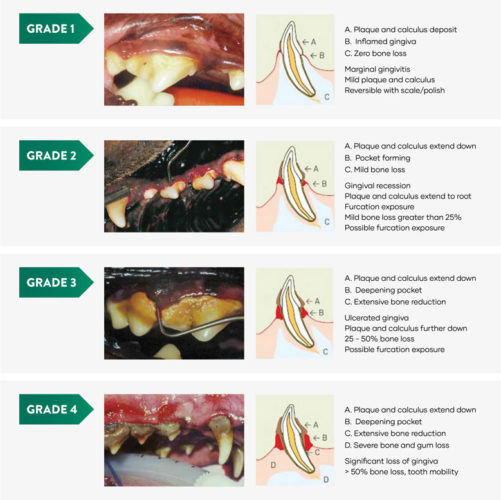
Imagine what your mouth would feel like if you never brushed your teeth or went to the dentist. For many dogs and cats, this is a painful reality. According to the American Veterinary Dental Society, more than 80% of dogs and 70% of cats have dental disease by the age of 3. Dental (or periodontal) disease is the most frequently diagnosed health problem in pets.
Common signs of dental disease include:
- Yellow or brown buildup (tartar) on the teeth
- Red, swollen, or bleeding gums
- Bad breath
- Excessive drooling
- Changes in eating or chewing habits
- Pawing at the face
- Loose teeth
- Depression
Even if your dog or cat does not have these symptoms, we recommend that you have a veterinarian evaluate your pet’s dental health at least once a year. Bacteria and food debris accumulate around the teeth and, if left unchecked, will lead to deterioration of the soft tissue and bone surrounding the teeth. This decay can result in irreversible periodontal disease, tooth loss, and possibly expensive oral surgery. Dental disease can also affect other organs in the body: Bacteria in the mouth can get into the bloodstream and cause serious infections in the kidneys, liver, lungs, and heart. If these problems are not caught and treated quickly enough, they can result in death. A physical exam combined with appropriate laboratory work can determine if infection in the mouth has spread.
We offer the following dental treatments
Dental cleaning – Every pet will need to have their teeth cleaned at some point in their life. This procedure allows us to remove plaque from your pet’s teeth. Once the plaque is gone, we will polish the enamel. This will help to prevent food from sticking to the enamel however, home dental care, in the form of teeth brushing must still be performed to retain good dental health.
Dental Extraction – Some pets may have to have teeth removed to relieve pain or to prevent the spread of infection. This is often the case if your pet has a broken or cracked tooth or if a tooth is infected. Tooth extractions are a last resort. Our aim is to work with pet owners to avoid extractions by providing preventative care.
For both procedures, your pet will be placed under general anesthetic. All patients are carefully monitored using advanced equipment and heat support is provided to ensure our patients are comfortable throughout. X-rays will then be taken using our digital dental x-ray unit. This allows us to view below the gum line and inside the teeth to better evaluate your pet’s oral health
Dental care at home
We understand that keeping on top of your pet’s dental care at home is not always easy but it is extremely important and there are a few options to help keep your pet’s mouth healthy. We are happy to show you how to care for your pet’s teeth
- Tooth brushing. We recommend brushing your pet’s teeth every night if possible. Please remember that pets require a special toothpaste and a pet toothbrush. Using the right tools and cleaning your pet’s teeth on a regular basis can help protect your pet from dental disease.
- Water additives. Water additives are like mouthwash for pets. Additives can be put in your pet’s water to help break down plaque and freshen your pet’s breath.
- Dental chews. Greenies dental chews are treats that can help fight plaque as your pet chews.

